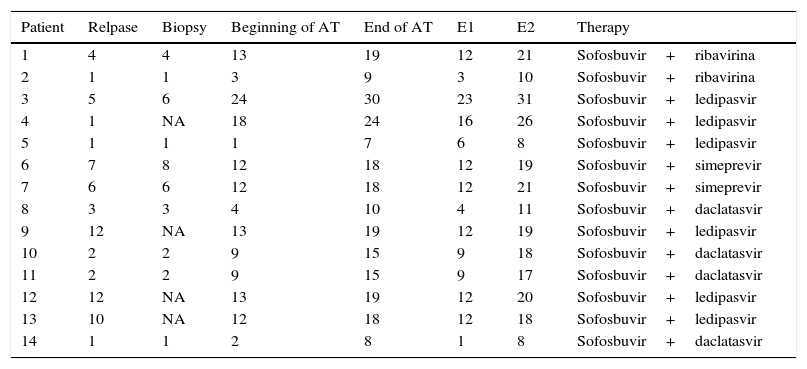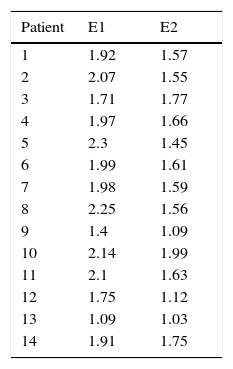To evaluate the changes in the values obtained in acoustic radiation force impulse (ARFI) elastography of the liver after antiviral treatment in patients with liver transplants and hepatitis C virus (HVC) infection recurring after transplantation.
Material and methodsWe studied 15 patients infected with HVC who had received liver transplants where an HVC infection recurring in the graft within one year after the transplant was treated with direct-acting antivirals. All patients underwent ultrasonography including Doppler and ARFI elastography in the three months before starting treatment with direct-acting antivirals (baseline study) and again in the three months after finishing the treatment. In the same week when the elastography study was done, liver function tests were done and the viral load (HCV RNA) was determined in peripheral blood with the polymerase chain reaction method. We used the Wilcoxon test for paired samples to compare the changes in the shear wave velocities before and after treatment.
ResultsAll patients achieved a virologic response that was sustained at 3 months after the end of treatment. On elastography, median shear wave velocities decreased after treatment (1.97m/s before treatment vs. 1.58m/s after treatment; p=0.001).
ConclusionThe shear wave velocity decreased significantly after antiviral treatment in patients who had relapsed HVC infection after liver transplantation.
Evaluar la modificación de los valores en la elastografía hepática tipo ARFI tras el tratamiento antiviral en pacientes con trasplante hepático e infección por el virus de la hepatitis C (VHC) con recidiva durante el postrasplante.
Material y métodosSe han estudiado 15 pacientes receptores de trasplante hepático con infección por el VHC y recidiva sobre el injerto durante el primer año tras el trasplante que fueron tratados con antivirales de acción directa. A todos ellos se les realizó ecografía basal, Doppler y elastografía hepática tipo ARFI en los 3 meses anteriores al inicio del tratamiento y durante los 3 meses posteriores a su finalización. En la misma semana de la elastografía se realizó analítica con perfil hepático y determinación de la carga viral (ARN-VHC) en sangre periférica mediante técnica de reacción en cadena de la polimerasa. Se ha estudiado el cambio en las velocidades de cizallamiento de la elastografía antes y después del tratamiento. El análisis estadístico se ha efectuado mediante el test de Wilcoxon para datos apareados.
ResultadosTodos los pacientes alcanzaron una respuesta viral mantenida a los 3 meses de finalizar el tratamiento. Se han encontrado diferencias estadísticamente significativas en las velocidades de la elastografía, con disminución de estas tras finalizar el tratamiento (la mediana de los valores de la onda de cizallamiento previos al tratamiento fue de 1,97m/s, y tras finalizarlo fue de 1,58m/s; p=0,001).
ConclusiónLa velocidad de la onda de cizallamiento disminuye de manera significativa tras el tratamiento antiviral en los pacientes receptores de trasplante hepático con recidiva de la infección por VHC.















